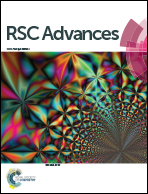Comprehensive study of the adsorption of an acylhydrazone derivative by serum albumin: unclassical static quenching†
Abstract
In this study, an acylhydrazone derivative, named N′-(2-chlorobenzylidene)-2-hydroxybenzo-hydrazide (NCH) has been synthesized by a one-pot synthesis method. Spectroscopy together with molecular modeling and electrochemistry were employed to investigate the binding behavior of NCH to serum albumin (SA), including human serum albumin (HSA) and bovine serum albumin (BSA), under physiological conditions. Unclassical static quenching has been proven in the fluorescence quenching of SA induced by NCH, due to the large activation energy requirement in the binding process. NCH was absorbed by both HSA and BSA with a 104 M−1 affinity constant. The primary binding driving force was the typical hydrophobic interaction occurring in Sudlow's site I of SA, while hydrogen bonds stabilized the NCH–SA complex and fixed the NCH configuration in the binding pocket. NCH could slightly destroy the polypeptide backbone and change the α-helix into an unordered ribbon. It was shown that NCH could efficiently bind with SA.


 Please wait while we load your content...
Please wait while we load your content...